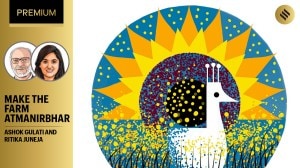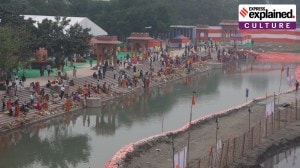The Crippled Poet
Bharata Natyam dancer, Rama Vaidyanathan, told me of a Bulgarian student, an ISKCONite, who said, “I am a Vaishnava. Do not teach me Sh...

Bharata Natyam dancer, Rama Vaidyanathan, told me of a Bulgarian student, an ISKCONite, who said, “I am a Vaishnava. Do not teach me Shaiva items.” She was advised not to learn the dance in that case, since it was a temple art that found expression in TN’s mostly ‘Shaiva’ temples. Now there’s a movement afoot, notably by some matams, to “unite Hindus under Krishna bhakti”. One can only turn away from such political manoeuvres and think instead of the grace of the Lord, showered equally as Nataraja, Ranganatha and Annai Velankanni. Or through the prayers of Gharib Nawaz and the Sikh Gurus.
One such legacy of faith is the Narayaneeyam, a great Sanskrit devotional text from Rama’s native Kerala. It is held in greatest esteem by ‘Shaivas’ and Srivaishnavas alike, its verses sung in worship at the great Krishna temple at Guruvayoor. Its author is Meppathur Narayana Bhattadri, a Namboodri Brahmin of Kerala. They say he was born in 1560 AD (Purandaradasa had four years left to live. In the north, Bairam Khan fell out with Akbar that year. Vallabhacharya had been dead nearly thirty years while Meerabai and Surdas sang on, humming bhakti like the honeybees stringing Kama’s bow). By about 16, Narayana Bhattadri was a proven prodigy, having mastered “all learning”. He was also an arrogant young person and a bit of a rake, if one can so interpret the cautious
remark by his historians that he was “morally indifferent”.
The only person that Bhattadri loved and respected was his grammar teacher, Achyuta Pisharady. When the guru fell victim to paralysis a few years later, Bhattadri was moved to take his teacher’s illness upon himself. He asked to be carried to Guruvayoor temple. Sending word to the great poet, Thunchath Ezhuthatchan, for advice, he was given the cryptic message, “Start with the fish”. Rightly interpreting this as a nudge to compose hymns on Mahavishnu’s ten avatars (which began with ‘Matsya’, the Fish), Bhattadri began to compose the Narayaneeyam. It was a condensed, original telling of the Srimad Bhagvatam in 1036 verses, completed in a hundred days. He was completely cured by the last day, November 27, 1587 (Vrischikam 28, year 763, Kollam Era) and, say some, lived to 106.
One belief goes that when it came to describing the Rasa Krida, Bhattadri dried up. He simply could not visualise it and surrendered to the Lord, saying, “You tell me how.” He was graced with a dazzling vision of Krishna dancing with the Gopikas. A lilting verse tumbled out: Keshapasha-druta- pinchikavatiti- sanchala- makara- kundalam/harajala- vanamalika- lalita-madgaraga-ghana-saurabham (Peacock feathers on your crown, fish-pendants in your ears, chains and garlands on your neck, your body smelling sweet of sandal). “On this radiant form, dressed for Rasa, let us meditate!” he concluded in ecstasy. It is this we want, don’t we?



- 01
- 02
- 03
- 04
- 05




























